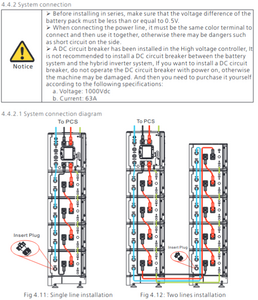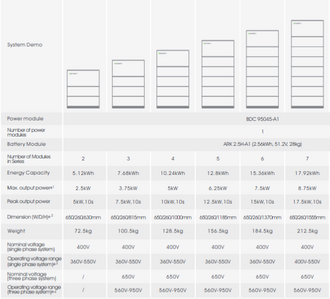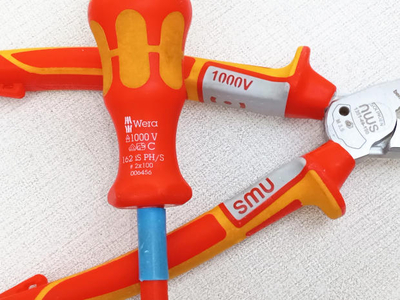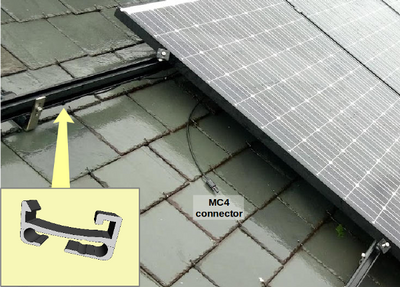Posted by: @agentgeorgeThis 0.5v is stated in the instructions you linked to.
Indeed, on p.19
That's the same page I was referring to earlier, where the connection of the power cables suggests that the battery packs are being connected in parallel.
But that still conflicts with Growatt referring to the ARK system as high voltage.
It's interesting that Growatt gives no advice to an installer as to how they should go about changing the State of Charge of a battery such that they do indeed match to within 0.5v
Given that they have their own dedicated Control Unit, and a BMS in each battery box, they could've included a feature by which that would be done automatically.
Posted by: @agentgeorgelast time I enquired, the cost of a 5kW pack had dropped to £1800.
So that's two more battery units, right?
It's an expensive way of having battery storage in the home.
Most of the price is being taken up with:
- a steel case
- BMS for each unit
- high-current cabling
- installer's on-site time
... and very little on the actual LiFePO4 cells.
Save energy... recycle electrons!
Posted by: @transparentThe key issue at the moment is whether there is any voltage on the battery connections to the inverter.
Depending on whether the Growatt ARK design puts the batteries in series or parallel, I would expect to see 52v or 104v DC.
I am pretty sure he assessed both.
What I can report is that I emailed Cahill and Growatt asking them to pay a visit and assess the battery (on warranty). No reply as yet.
Thanks everyone for the input so far!
@transparent yup, the cost no longer has VAT, but installer cost, for 2 people is £300-400, profit for company 50%
so battery wholesale cost is around £700 which includes the BCM and sexy magnolia metal case, oh and some big cables
High Voltage is anything over 12/24V, PV at 48/52 and Hybrid batteries 48V in cars are all covered under HV regulations for approved installers
Traction batteries at 400-800V are just plain lethal. They have batteries in series and parallel to achieve the voltages. Some cars can “fold” their batteries so an 800v architecture can look like 400v to a charging station.
@agentgeorge High Voltage means different things in different circumstances; as an audio engineer, I used 48 v. DC to power microphones and this is known as ‘Phantom Powering’ but does not require high voltage warning labels etc. I also did some work for a telecomms company who required a test rig that supplied 50 v. DC for ringer circuits and this was technically referred to as High Voltage! Regards, Toodles.
Toodles, heats his home with cold draughts and cooks food with magnets.
My take on it is microphones need mAmps whereas cars need Amps. although both work on 48V, one will give you a buzz, the other will launch you across the room. Hence why in cars HV wiring and connectors are orange
Posted by: @agentgeorgeHigh Voltage is anything over 12/24V
I think that is going to cause confusion.
And for that reason I ought to state what other 'authorities' use for high/low voltage.
The UK grid operators use Low Voltage (LV) when referring to anything below 1000v AC.
That makes sense because 1000v is the rating for the insulation level on tools used by 'domestic' electricians.
75v AC is usually regarded as the voltage level at which you must employ an accredited electrician to work on electricity wiring and hard-wired devices within the home.
However, that value isn't stipulated in law. The regulatory view is that an electrician is required when there is a risk of danger to life.
I like that because it's based on safety rather than analysing a voltage waveform!
Below 50v (AC) or 120v (DC) is referred to as Extra Low Voltage (ELV).
ELV is further defined in specific legislation which recognises three variants
- SELV = separated extra-low voltage
- PELV = protected extra-low voltage
- FELV = functional extra-low voltage
I meet all three of those categories in my work with Smart Controllers.
Save energy... recycle electrons!
Posted by: @transparentI'm sorry @batpred - I'm finding it difficult to follow what you're saying here.
1: In this case no electrician has alerted @eliuccio regarding the type of RCBO.
Apologies as my post clearly interrupted this flow. When I read one of the posts, I thought it could be understood that in case an electrician does some work, they need to put everything right. I believe that they just have to inform.
From practical experience, if the budget does not allow for it, they just install a small consumer unit for the specific work.
Posted by: @transparent2: Your second sentence is a double negative.
Are you saying that an electrician can or cannot fix a 'fault' on a battery without also changing the type of RCBO which supplies the inverter?
I am not stating anything as I am not clear what principle is followed when Part P details are updated. As in, which of the two would apply:
1- when fixing a fault, the electrician would need to make sure that everything else in the circuit (even if not relevant) is updated to the latest norms in the installation.
2- when fixing a fault, the electrician could not upgrade the rest of the installation.
This is since work needs to be paid and an electrician would not work for free if the client has not budgeted for it?
Posted by: @transparent3a: You wrote: "some of the risks associated with lack of bidirectional RCD/RCBOs can catch even experienced electricians, so I would get it replaced."
I don't follow your logic here. I've just made precisely the opposite point.Whether or not an electrician understands the risks isn't relevant because electricians will simply implement the regulations.
This has not been my experience, not when upgrades are made. The regulations naturally do not provide a single way to design the circuits, there are options and the client will clearly have an input.
Posted by: @transparent3b: You wrote: "But once you look to match the exact specs needed, this can be tricky. So this is not always a simple job. My inverter is an 8k hybrid and for this rating, this is not so simple."
Why?
This is just a general comment. When looking to buy the components, I find that they are often not widely available in SE England. But for lower ratings they are.
Everybody is different, but if something is simple/cheap to replace, people would just get it done. When it requires all sorts of rewiring, costs mount and people will reasonably question why this was not prevented.
Posted by: @transparentWhat warning are you giving to other readers who might also have an 8kW hybrid unit?
And why?
For anyone with a high powered inverter, my general advice is the same: "to make sure that the installation is safe". What that means, is something that each person needs to evaluate for themselves, and electricians are the ones that know the regulations. What they do not know is the budget, the preferences in terms of disruption, the ideal timing, their own view of the risks, etc.
Posted by: @transparentIt is important that advice given on this forum is accurate and can be substantiated.
This is more-so the case when it is a safety issue.Please state your sources.
I do not have any specific source for these insights, just practical experience and knowledge of electricity.
I agree the advice needs to be accurate.
My intention was just to use the conversational style that is often used in this forum.
16kWh Seplos Fogstar battery; 8kW Solis S6-EH1P8K-L-PLUS hybrid inverter; Ohme Home Pro EV charger; 100Amp head, HA lab on mini PC
Thanks for the response @batpred
Your conversational style would be useful input if it includes references to sources.
In other words, opinions need to be substantiated.
As we've discussed elsewhere, this is becoming increasingly important now that AI bots are taking information from this forum and then using it to inform others.
Let me pick up one specific point you've just made:
Posted by: @batpredThis is just a general comment. When looking to buy the components, I find that they are often not widely available in SE England. But for lower ratings they are.
If that's what you're experiencing, then let's have that point made in a new Topic with a Subject Title which allows others to find it.
Many of us here have decades of experience in trying to find 'difficult' parts.
I'm pretty sure that our combined knowledge will allow us to tell you where to source 99% of what you're looking for.
Moreover, I have recently been creating parts which are not (readily) available by using a 3D printer.
As an example, I designed a number of different types of cable clips to safely hold PV panel wires.
These prevent wires being chafed by rough edges of the slate roof, which would eventually lead to over-heating.
Save energy... recycle electrons!
Just to update on the topic of this thread: Cahill engineer is coming today after having threatened both companies of bad reviews and legal action.
They will try to switch the battery back on. I hope today's visit will at least disclose why the batteries are disconnected.
Cheers,
E
That's better news.
If Cahill can locate the problem today, then they will receive (free) accolades here in the Forum, of course!
At this stage I don't think we're too concerned what the fault turns out to be.
It just helps to know what went wrong, and how we might've better analysed the symptoms in our discussions.
It could be anything from a damaged component to a software/configuration error.
Something is obviously still alive because you did actually receive data across the Growatt Shine App...
... telling you that zero power was being transferred anywhere.
But both monitored devices still had entries in the Power fields (73.4W and -225.1W respectively).
Save energy... recycle electrons!
Posted by: @transparent...
Something is obviously still alive because you did actually receive data across the Growatt Shine App...
... telling you that zero power was being transferred anywhere....
From my experience of the Shine app, I'd say that's not a safe assumption. I'd say it's confirming the inverter is up and running and the wifi dongle is connecting to the Internet but beyond that I'd call anything it says indicative rather than proof. My Shine app is, for instance, telling me I've never consumed any of my PV output....
105 m2 bungalow in South East England
Mitsubishi Ecodan 8.5 kW air source heat pump
18 x 360W solar panels
1 x 6 kW GroWatt battery and SPH5000 inverter
1 x Myenergi Zappi
1 x VW ID3
Raised beds for home-grown veg and chickens for eggs
"Semper in excretia; sumus solum profundum variat"
Back to this as I thought it could be useful to track back some of the raised points
Posted by: @transparent2: There's a separate RCBO marked "solar" which may be in series with the Chint meter.
I don't know when this solar installation occurred, nor can I see the printing on that RCBO.However, it's likely that the RCBO needs changing for one which can support bi-directional operation. See this explanation.
This is a safety issue. Feel free to post a close-up of the existing trip and ask for further clarification if you want.We'll assume that the Solar circuit is what connects to the Growatt 3600 TL.
The TL range is known to me.
There's one sitting on the floor beside me as I write!3: Left of the Main Switch is a trip marked SPD MCB
SPD is Surge Protection Device.
There's one to the right of the Main Switch, coloured red.Unless the manufacturer states otherwise, SPDs shouldn't have any trip between them and the busbar of circuits they are there to protect.
If a surge were to enter the property from the grid, the MCB's contacts would fly open, thus isolating the SPD.
That renders it useless.
It won't be connected at the very moment when it's meant to be quenching the surge!7: The rating of the Service Fuse at 60A will have been decided by your DNO, which is UK Power Networks.
This rating depends on the current-carrying capacity of the supply cable to the house.
You can't just have a larger fuse because you want to draw more power!If this house was in my area, where the DNO is National Grid (NGED), then you would've been told an upgrade to three-phase is required.
2. The engineer changed the RCBO for a bideractional one.
3. They also said that the SPD is linked to the main switch (I didn't catch very well why from the explanation he gave me, but he implied it was functional and nothing to be concerned with).
7. I wrote to UK PN but haven't received a reply yet. Hopefully they will in due course. The engineer agreed the upgrading would be a good idea.
Back to the batteries: They just needed to be turned on. My electrician was wrong, saying that touching the quadrant could have been very dangerous. The engineer clarified that all the switches and fuses are isolated. It was only the case of switching on and off to check that the batteries were back on and seen by the Inverter. However, some updates were needed, so Growatt did that too.
In conclusion, there is no clue on why the batteries went off but 1. I had the RCB changed and 2. I learnt I can access that panel with no fear, as well as knowing now what I have to interact with (picture attached).
Success, though I have lost quite an amount of money in the process.
Lesson learnt. I hope this won't happen again of course, otherwise it may cast a shadow on the functionality of the system.
Thanks for the help and support provide on this matter!
- 26 Forums
- 2,342 Topics
- 53 K Posts
- 400 Online
- 6,000 Members
Join Us!
Worth Watching
Latest Posts
-
RE: Configuring third party dongle for Ecodan local control
However, I've found the documentation doesn't work exac...
By F1p , 15 minutes ago
-

RE: Setback savings - fact or fiction?
@robs — thanks again for your detailed comments. Some r...
By cathodeRay , 55 minutes ago
-
RE: Are We Sleepwalking Into Another Race to the Bottom?
The thing that worries me is that this brainless crap i...
By JamesPa , 2 hours ago
-
RE: Free Ecoheat Heat Pump Install
I don't mind thread drift, it's how conversation natura...
By Deltona , 3 hours ago
-

RE: A Smarter Smart Controller from Homely?
@papahuhu I hope you get a swift resolution. Regards, T...
By Toodles , 5 hours ago
-

RE: Poll for Time of Use, tariffs, technology
That’s fine by me too Major, I feel it is a sad reflect...
By Toodles , 6 hours ago
-

Bingo. Sometimes a judiciously placed size 10 bovver bo...
By Majordennisbloodnok , 6 hours ago
-
RE: Mitsubishi Ecodan 11.2kW heat pump with low COP
@ciocoiu-alexandru I can't provide the same level of di...
By Sheriff Fatman , 7 hours ago
-
RE: Octopus Cosy Heat Pump Owners & Discussion Thread
Recently had my follow up with octopus for the vibratio...
By swwils , 8 hours ago
-
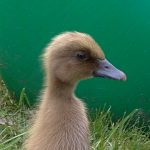
The three technical issues I'm considering are: BMS...
By Transparent , 9 hours ago
-
RE: LiFePO4 lithium battery fires and explosions
@transparent Your post may fit better in th...
By Batpred , 9 hours ago
-

RE: British Gas vs Octopus Energy vs Heat Geek vs EDF vs Aira vs OVO vs EON.Next vs Boxt
@jamespawhite, if you could be bothered, you could also...
By Mars , 11 hours ago
-
RE: Commencing on an ASHP Installation Process
I've got a bit of time to draft something today, so the...
By Sheriff Fatman , 1 day ago
-
RE: Help with heat pump sizing
@amin I dont think materially relative to t...
By JamesPa , 1 day ago
-
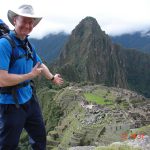
@majordennisbloodnok I have decided to take the plunge....
By TechnoGeek , 1 day ago
-
RE: Different dT on each radiator?
I cant sorry. Its based on some calculations I did fro...
By JamesPa , 2 days ago
-
RE: Help me keep the faith with my air source heat pump installation
@simonf thats interesting as I’ve noticed my flow and r...
By AdamK , 2 days ago
-

RE: MELcloud scheduling misbehaviour
No, it gets to set temperature easily even during perio...
By Abernyte , 2 days ago

